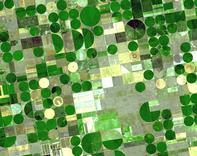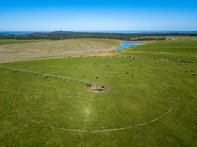When to irrigate pastures and how much water is needed? Or is it even necessary to irrigate?

Depending on the area, rainfall may provide sufficient moisture for certain crops, but in times of changing weather patterns, irrigation now often needs to supplement rainfall. Too much water, apart from being wasteful and expensive, can also leach out nutrients and cause waterlogged soil. In contrast, too little water can retard pasture growth.
Irrigation Requirements of Pasture Crops
Clover
Clover is grown in areas suitable for ryegrass production. White and red clover needs 800 mm or more per year. Irrigation: 25 - 50 mm per week. Poor drought tolerance. Balansa clover can be grown under 350 mm of rainfall while Berseem clover needs an average rainfall of over 600 mm, or less if supplemented by irrigation.
Cock’s foot
Cock’s foot grows well in cooler climates with rainfall over 900 mm. It reacts well to irrigation but not as good as other pasture crops.
Eragrostis tef
No irrigation is needed for tef as it grows well under dryland conditions or where rainfall is over 400 mm.
Fescue
Fescue is normally grown in high rainfall areas and will benefit from irrigation during the dry winter months in summer rainfall areas. Suitable for planting in marshy or wet soil.
Foxtail buffalo grass
Very drought tolerant, foxtail can grow in conditions ranging from 100 mm - 1 000 mm rainfall per year, but cannot tolerate waterlogged soil. Under irrigation, the forage can be harvested up to ten times per season in intervals of 35 to 40 days.
Guinea grass (Panicum maximum)
More than 500 mm of water per year is needed to grow a fair crop of Guinea grass.
Kikuyu grass
Rainfall of more than 750 mm is needed for Kikuyu production, but it can grow in lower rainfall areas where irrigation needs to supplement its water requirements.
Lucern
Suitable as a dryland pasture with rainfall lower than 500 mm, lucerne’s yields improve under irrigated conditions.
Paspalum
Can be irrigated or grown under dryland conditions where rainfall is at least 650 mm.
Rhodes grass
Rhodes grows naturally in dry areas of the Eastern Cape but can grow in subtropical areas with a rainfall of 400 mm - 1 000 mm.
Ryegrass (annual)
Not suitable for dryland production. Ryegrass should be grown in areas with an average summer rainfall of over 1 000 mm. Recommended irrigation in most soil types are 25 mm every 4 to 5 days if planted during January/February and then 25 mm weekly for the rest of the growth period.
Ryegrass (perennial)
Suitable for production in cooler areas where rainfall is spread over the season and exceeds 1000 mm.
Smuts finger grass
Adapted to dry areas and prefers summer rainfall of over 500 mm. Not suited to waterlogged soils.
Sorghum
As a drought-tolerant crop, sorghum is suitable for dryland pastures or where rainfall is 400 mm or more.
Babala or pearl millet (Pennisetum glaucum)
Also a drought-tolerant crop, babala is suitable for dryland pastures or where rainfall is 400 mm or more. Does not tolerate wet soils.
Weeping lovegrass (Eragrostis curvula)
Lovegrass prefers light soils and rainfall of over 650 mm but can survive with an average rainfall of 450 mm. Irrigation may supplement rainfall.
When to Irrigate Pastures

The frequency of irrigation depends on the crop species, availability of water, soil water content, the rate of evapotranspiration and the depth of the pasture plant roots.
The Water Research Council (WRC) recommends that with each irrigation, the soil must be brought to field capacity in the root zone of the pasture. Simply put, this means longer irrigations, less often.
Frequently, irrigation is applied too late which then can lead to a delay in nitrogen fertilisation. Usually, fertiliser is applied after a pasture is grazed or cut for hay and befóre irrigation.
By Marinda Louw